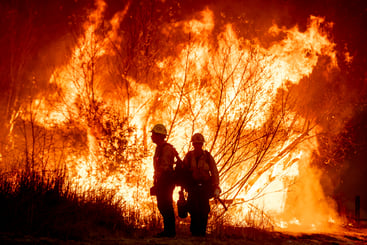Lower Sioux Indian Community’s Response to COVID-19: Community Health Perspective
Lower Sioux Indian Community’s Response to COVID-19: Community Health Perspective

Name: Stacy Hammer, RDN, LD.
Tribe(s): Bdewakantunwan Dakota
Location: Lower Sioux Indian Community (Cansayapi) - Morton, MN
Title: Director of Community Health at Lower Sioux Health Care Center
Stacy Hammer is Bdewakantunwan (Spirit Lake Dwellers) Dakota and comes from Cansayapi (Where They Paint the Trees Red), otherwise known as Lower Sioux. Stacy is currently working as the Director of Community Health and Registered Dietitian for the LSIC. She has been instrumental in working with the LSIC Tribal leadership in addressing COVID-19.
In rural Minnesota, the Lower Sioux Indian Community (LSIC) is doing everything they can to take care of their most vulnerable tribal members in response to COVID-19. Stacy Hammer (Bdewakantunwan Dakota) is on the frontlines as the Director of Community Health.
“So far, we have no confirmed cases. But, when we do, I feel those of us who are left working, will be ready, to the best of our abilities due to the resilience and perseverance of our people to help those who need it most,” states Hammer.
Stacy’s viewpoint on how the pandemic has impacted her community in the past two weeks is shared here.
Community is everything.
Managing a public health crisis that has a domino-effect on almost every aspect of a person’s life is unprecedented, but what is certain is that Native communities don't need reminders about community care—we've relied on it for centuries.
Communication is key.
From meeting twice weekly, to daily, to hourly, the LSIC Tribal Council and LSIC COVID Response Team have made regular communication with their community a priority. They also include external contacts in meetings, such as the casino’s General Manager. Communication has helped keep the community calm and reassure elders that Tribal leadership was preparing to be ready to respond.
Finding ways to leverage resources has aided in taking care of elders and youth.
By far, the most pressing issue is getting food to elders and youth. LSIC has found ways to do this by finding extra funds from unrestricted funding sources.
Food for elders: By working with the casino, meals can be prepared and distributed to elders for the weekend. Also, using extra funds to bulk order non-perishable food, box items, and deliver to elders.
Food for youth: By leveraging school meals and recreation center staff, breakfast and lunch is delivered to youth while schools are closed.
Making tough decisions for the health of the community is inevitable.
The decision to close the Recreation Center, which happens to be the heart of the community, was one of the toughest. Kids aren’t in school and want to interact with friends. Finding child care is challenging or impossible. However, many tribal youth also have an elderly person in their home. Providing a kid-friendly place and then sending kids back home to their elderly caregivers seemed irresponsible.
Adjusting health care delivery is necessary for continuity of medical care.
Health Directors understand that chronic disease management and treatment must go on. The LSIC Health Center has made arrangements to deliver medications to those over 60 with high-risk conditions, such as diabetes, heart disease, and respiratory issues. This is just one example of how the tribal health center has adjusted health care delivery.
The uncertainty of how business closures impact the local economy is alarming.
Lower Sioux Indian Community’s casino is the largest employer in the vicinity. When the casino closes, staff will be without income which will force a greater need for food and resource assistance. Subsequently, any revenue that assisted tribal members will be lessened or absent, causing another major hit to elders with limited income.
Maintaining operations requires patience.
Funding sources and the programs they fund still have to be managed. The logistics of figuring out who can work from home, who is considered “essential”, which pot of money funds a position, and who must come in to work, heavily depend on the guidance of funders. And, what happens when staff aren’t able to work? Most likely Directors take on more duties to keep programs afloat. The same Directors who are managing the overall COVID-19 crisis.
There’s no fun in forecasting the future and addressing “what if” scenarios.
Luckily, six miles away is a COVID-19 testing site; however if an elder has symptoms, who drives them to get tested? These are the kinds of situations and questions that community and Tribal leaders have thought through at LSIC. In this community, and others like it, the scenarios are changing by the hour. Looking ahead to what they’ll need to be ready for next is still uncertain.
Practicing and prioritizing self-care (and humor) is good medicine.
Being on-call and working long days is emotionally, physically, and mentally exhausting. Regular practices like smudging, burning cedar, and keeping nourished and hydrated has been vital so far. It will be even more important in order to get through this collectively -- as a healthy and happy community.
How can the general public help your community right now?
Access to food. Our small community does not have an emergency food shelf program, nor do we have space to store large quantities of food. Offering a pop-up food pantry would be ideal, especially for those who are laid off or are not receiving meals or other food assistance. Larger food banks in the metro are receiving donations, but smaller communities do not.
For more information and resources specific to Native communities, browse Native Americans in Philanthropy’s COVID-19 Resources page.
Native Americans in Philanthropy and community organizations and nonprofits throughout Indian Country, are actively responding to the guidance from Tribal and local governments in an effort to meet the needs of our communities. The information shared here was current on the date it was posted, but may have changed since then.



Comments